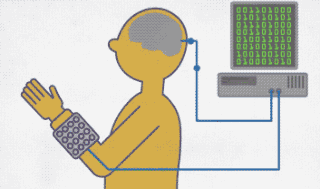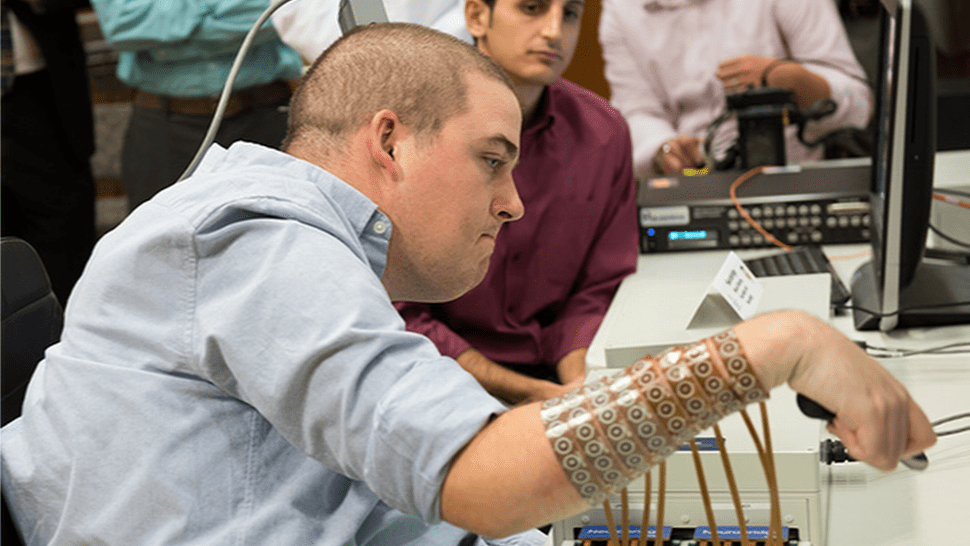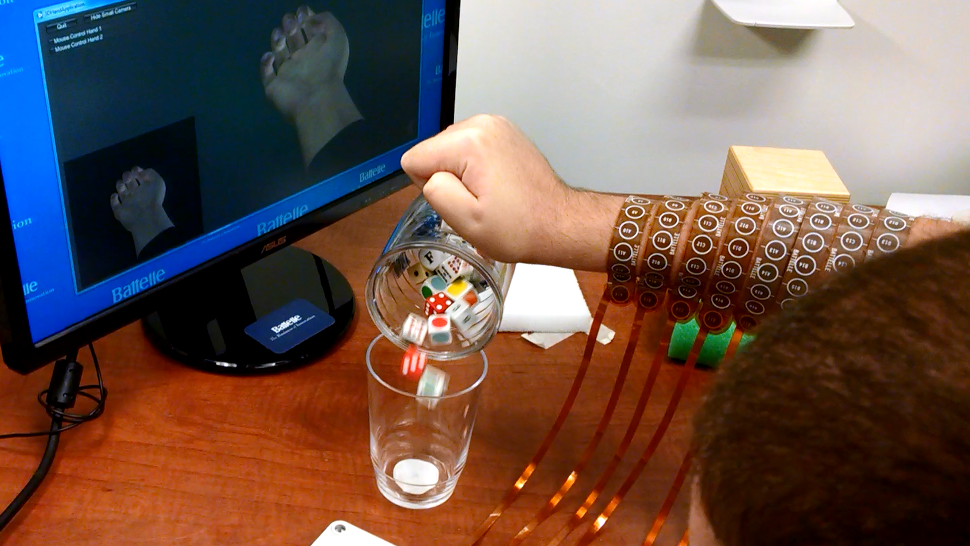Six years ago while holidaying with friends, Ian Burkhart suffered an accident that left him paralysed from the shoulders down. A new system now allows him to make complex movements with his hand and fingers, making him the first person in history to regain function using signals from his brain.
The system, called NeuroLife, is allowing Burkhart to make functional movements, such as picking up utensils, pouring the contents from a bottle, swiping a credit card — and even playing Guitar Hero. It was developed by researchers from the Battelle Memorial Institute, with a little help from Ohio State University’s Wexner Medical Center.
The device, described in the latest edition of Nature, uses an artificial neural bypass that reroutes signals from Burkhart’s brain to the affected muscles. It’s the first time that a paralysed person has regained movement just by using their thoughts, and it’s poised to revolutionise the way paralysed patients and other motor-impaired individuals are rehabilitated.
Burkhart was only 19 years old when the accident happened. While swimming with friends, he misjudged the depth of the water and dove head-first into a sandbar, breaking his neck. His injury made him a C-5 quadriplegic, unable to move any part of his body below his shoulders. Doctors told him he’d never walk again or regain function in his hands; the signals from his brain, though intact, could not get past the blockage at the site of the injury.
Undaunted, Burkhart told his doctors and therapists that he was willing to go the extra mile during his rehabilitation. This led him to Battelle’s Nick Annetta and Ohio State University’s Ali Reza.
“I had a feeling after my accident that there would be some improvements in science, technology and medicine that would improve my quality of life,” Burkhart told Gizmodo in a phone interview. “I’ve always been a big fan of technology, and because I was getting therapy at Ohio State, I knew about the kind of work being done there. I just made my interest known, and once the researchers got to a point where they were looking for a test subject, they contacted me. Luckily, I was able to check off all the boxes listing the requirements they were looking for.”

Outline of the NeuroLife system. Image: Ohio State University/ Batelle
But when the Ohio State researchers explained the project to Burkhart, he said it sounded like something right out of a science fiction movie. He questioned whether it could even be done. “But the more I talked to the team, the more faith I had in their knowledge and skillsets.”
The NeuroLife system really does look like it could have come from the future. It’s basically an electronic detour for obstructed brain signals. The device interprets intentional brain signals that would normally be channelled through the spinal cord, sending it to the desired muscles via cables. An electrode-equipped sleeve is worn above the wrist, triggering the required muscle contractions.
The first step of the project was to implant a tiny, pea-sized microelectrode array in the motor cortex of Bukhart’s brain. Unlike similar techniques that use EEG caps to record the brain’s electrical activity off the scalp, this system is invasive. The 96-channel chip implants directly into his brain, while a cable port sits at the back of his head. The device taps into a few hundred motor neurons, providing enough information for the execution of basic physical tasks. Even after two years, the device is still churning out signals of excellent quality. The chip is actually functioning better than the researchers expected.
In the days and weeks following the three-hour surgery (done back in 2014), Burkhart suffered from headaches and some pain at the incision site, but it’s not something that bothers him any more. As for the coin-sized pedestal in the back of his head, he barely even thinks about it.

Burkhart testing the device. Image: Ohio State University/ Batelle
The next step was to train a computer to understand the signals coming out of Burkhart’s motor cortex (the part of the brain responsible for physical movements). At this early stage, the researchers simply wanted to know if the system would work, and they got their proof-of-concept when Burkhart successfully used his thoughts to open and close his hand. Armed with this validation, the researchers were able to advance to the next stage, which was to give Burkhart finer control over his hand and fingers.
Burkhart had to train a computer to understand the various brain patterns associated with particular movements. For Burkhart, this process proved to be tedious, time-consuming and gruelling. He hadn’t thought about moving his hands and fingers in years. The sessions left him mentally and physically exhausted.
“Over the 19 years before my accident, I had really taken it for granted that I can have so much control over my hand,” said Burkhart. “So while training, I really had to break down my thought processes, and in a natural way that could help the computer learn so that we can work together. The most mentally exhausting part was trying to block out everything else that was going on in my brain and focusing all my concentration and energy on just that one movement.”
Burkhart got better at this task over time, and now he requires just 10 to 15 minutes to train the computer. Unfortunately, the system has to be trained for each and every session due to the transient nature of brain signals — but the machine learning interface is getting progressively better and faster at mapping Burkhart’s brain patterns. So both Burkhart and the computer are learning together.

Ian Burhkart swiping a credit card. Image: Ohio State University/ Batelle
To get Burkhart’s hand and fingers to move, a receiving device is placed on his arm like a cuff. This 130-electrode device doesn’t require additional surgery, and it provides stimulation to targeted muscles, causing them to contract (and no, it doesn’t hurt). Each finger is controlled by 20 electrodes, while the remaining 50 control the hand. Burkhart uses his thoughts to trigger a specific sequence of firing patterns, allowing him to rotate his hand, make a fist or pinch his fingers to grasp an object. He can scarcely believe the progress they have made in less than two years — and it’s better than he ever imagined.
“I thought that just getting my hands to move would take a lot of time,” he said, “Now we’re able to do many more movements, including complex hand movements and fine finger control where I can actually pick up objects. The speed at which everything is evolving is assuring me that this is going to be something that will eventually be used by a lot of different people to improve their quality of life.”
During testing, Burkhart showed that he can perform surprisingly complex movements with his hands and fingers, such as picking up a spoon or cup, holding a phone to his ear and pouring the contents from a bottle. He can also control the strength of these movements. Burkhart also showed that he can use the system to play Guitar Hero.
“It’s kind of crazy that this system works well enough and responds quickly enough for me to be able to play the video game with the amount of accuracy and response times that are needed,” Burkhart told Gizmodo. “The amount of latency from the point I think about it from when the finger moves is really negligible. I can see the notes coming down on the screen and think a little bit ahead, but I’m really playing the game in a way that’s very natural.”
Burkhart said there were a couple of times when he “got sick of playing the same song over and over again”, but he admitted it was a lot more fun that the other training sessions.

Ohio State University/ Batelle
Playing video games is all fine and well, but Burkhart said he was most impressed with the ability to pick up a bottle, pour its contents and then stir it with a stir stick. “That task was really special to me,” he said, “because that can translate to so many different things.” He said the ability to go from a large hand movement to one requiring finer dexterity shows just how robust the system really is.
NeuroLife is currently confined to the lab, but Burkhart is hoping to take it elsewhere. He’s constantly nagging the researchers about taking it home. Burkhart sees the system as a way for him to finally regain his independence and autonomy.
“It’s something that the researchers are definitely working towards, but right now the system is kind of bulky. It requires big cables that come right out of my head, and then to a processing unit which feeds a computer, and then out to another processing unit that controls the stimulation,” he said. “So there are a lot of components in the system that need to be simplified and reduced in size in order for it to be something feasible for use outside the lab.”
This is exactly what the researchers intend to do. According to project leader Chad Bouton, they’re hoping to reduce NeuroLife in size to the point where it becomes invisible. Eventually, the system could be made wireless, and the sleeve replaced by implanted electrodes in the hand and fingers. Bouton is also hoping to see the technology applied to other patients, including people who have suffered a stroke; he said this is just the “tip of the iceberg” in terms of potential applications.
As for Burkhart, he will continue to do what he can to help push the technology forward, saying he feels very lucky to be involved in the study.
“I have really enjoyed every second of it, and even if it doesn’t benefit me and my everyday life, I know the work we’re doing is part of a bigger problem that could benefit a lot of other people,” he said. “Much more work still needs to be done by many more people in order to solve this problem of regaining movement, but I feel that I’m a piece of this puzzle, and I’m glad to be a part of it.”
Ian Burkhart has set up a foundation to help individuals with spinal cord injuries. You can donate here.
[Nature]
